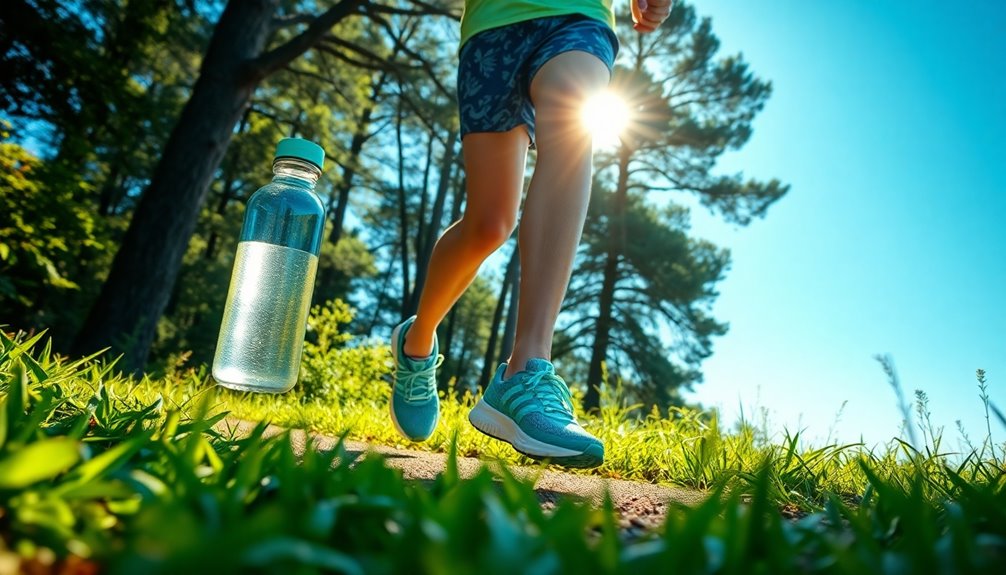If you're looking to make your running routine more eco-friendly, choosing sustainable gear is key. Opt for apparel made from recycled materials, like polyester from plastic bottles, or organic cotton for comfort. Incorporate practices like plogging—picking up litter while you run—and seek out eco-certified races to boost your community impact. By supporting brands that prioritize ethical manufacturing and transparency, you can truly enhance your green lifestyle. Discover more ways to run sustainably and benefit both your health and the planet.
Key Takeaways
- Choose running gear made from recycled materials, like recycled polyester, to reduce textile waste and lower carbon emissions.
- Opt for eco-certified races that prioritize sustainable practices and biodegradable materials for a responsible running experience.
- Engage in community activities like plogging to combine fitness with environmental stewardship and promote local cleanliness.
- Support brands with ethical manufacturing processes and certifications like OEKO-TEX and bluesign for safer, sustainable products.
- Extend the life of your running gear through repairs, repurposing, and choosing durable items to minimize waste.
The Importance of Sustainable Running Gear

As you lace up your shoes for a run, consider how your gear impacts the planet. Choosing sustainable running gear isn't just a trend; it's essential for minimizing environmental harm.
By opting for eco-friendly products that use recycled materials, you're helping reduce landfill waste and conserve resources. Sustainable practices in the industry, like utilizing organic cotton and recycled polyester, cut down on carbon emissions and water usage.
Brands such as Craft and Brooks focus on eco-friendly manufacturing processes, ensuring their products boast a lower carbon footprint.
Eco-Friendly Materials in Running Apparel

When you're choosing running apparel, consider the materials that make up your gear, as they play an essential role in both performance and sustainability.
Look for eco-friendly gear that incorporates sustainable materials like recycled polyester, crafted from recycled plastic bottles. This greatly cuts down on textile waste.
You might also find biodegradable options like Tencel lyocell, which uses less water and no harmful pesticides compared to conventional cotton.
Innovations such as BottleKnit™ highlight the use of upcycled industrial waste, further reducing your carbon footprint.
Additionally, many brands prioritize organic cotton, enhancing comfort while promoting ethical farming practices.
Certifications like OEKO-TEX and bluesign guarantee these materials meet safety and sustainability standards, making your choices even more impactful.
Sustainable Practices for Runners

When you're out for a run, consider choosing eco-friendly routes that minimize your impact on the environment. Bring a small bag to collect any litter you find along the way, turning your workout into a chance to help your community. Additionally, consider Leave No Trace principles to ensure you're being mindful of your surroundings while enjoying the outdoors.
Eco-Friendly Running Routes
While you lace up your running shoes, consider how choosing eco-friendly routes can enhance your experience and benefit the planet. By opting for local trails and parks, you not only reduce travel emissions but also support community engagement. Look for races certified by eco-friendly organizations to guarantee they prioritize sustainability. Participating in plogging events lets you combine running with environmental stewardship, helping to clean up your local ecosystem.
| Route Type | Benefits | Tips |
|---|---|---|
| Local Trails | Reduces travel emissions | Explore nearby parks |
| Eco-Certified Events | Promotes sustainable practices | Research certified races |
| Plogging Events | Combines fitness with cleanup | Gather friends to join you |
Choose wisely and make a positive impact!
Minimizing Waste During Runs
Minimizing waste during your runs is essential for promoting a sustainable lifestyle. One great way to start is by plogging—jogging while picking up trash helps keep your local area clean and boosts your fitness.
Choose races that prioritize sustainability, like those certified by the Council for Responsible Sport, to support environmentally conscious practices. When you hydrate, opt for biodegradable materials, such as paper cups, instead of single-use plastic.
Additionally, washing your running gear less frequently and air drying can greatly reduce microfiber output, protecting our waterways. Regular cleaning methods, like using mild soap and water, can also help maintain your gear without causing environmental harm.
Finally, consider repairing or repurposing old running gear—transforming T-shirts into cleaning rags or dog toys can extend their life and reduce waste, making a positive impact on the environment.
Prominent Eco-Conscious Running Brands

When it comes to eco-conscious running, several brands stand out for their commitment to sustainability.
You've got companies like Allbirds and Patagonia that prioritize innovative materials and ethical manufacturing practices.
These brands not only create high-performance gear but also contribute to a healthier planet.
Innovative Sustainable Materials
Many eco-conscious running brands are leading the charge in utilizing innovative sustainable materials, making strides toward a greener future.
For instance, Girlfriend Collective transforms 25 recycled water bottles into their Compressive Leggings, showcasing a commitment to using materials made from recycled materials.
Tentree's InMotion collection features certified recyclable plastic, ensuring each purchase helps plant trees and reduce carbon emissions.
RDX Sports upcycles industrial waste in their manufacturing processes, minimizing environmental impact while delivering high performance.
Organic Basics offers Tencel lyocell, a biodegradable option created with recycled water and non-toxic substances.
Ethical Manufacturing Practices
As the demand for eco-friendly running gear grows, brands like Patagonia and Brooks are stepping up with ethical manufacturing practices that prioritize both the planet and workers.
Patagonia guarantees safe working conditions and fair labor through fair trade certified factories.
Girlfriend Collective takes it further by using 25 recycled water bottles to craft their Compressive Leggings, blending sustainable materials with ethical labor standards.
Brooks utilizes carbon neutral credits to reduce greenhouse gas emissions in manufacturing.
Vuori also employs recycled polyester and eco-friendly practices, while ASICS incorporates bio-based materials and eco-friendly dyeing solutions.
Brand Commitment to Sustainability
With the rise of eco-friendly running gear, brands are stepping up their commitment to sustainability, creating a significant impact on the industry.
For instance, Craft focuses on sustainable materials and eco-friendly manufacturing, ensuring their apparel minimizes environmental harm.
Brooks takes it a step further by utilizing carbon neutral credits for their popular products, effectively reducing their carbon footprint.
Vuori prioritizes renewable materials in their eco-friendly manufacturing processes, showcasing their dedication to responsible sourcing.
ASICS incorporates bio-based materials and eco-friendly fabric dyeing solutions, enhancing their sustainable gear line.
Puma also collaborates on sustainable initiatives, reinforcing their commitment to environmental stewardship.
How to Identify Eco-Friendly Running Gear

How can you guarantee your running gear is eco-friendly? Start by looking for products with a green leaf icon, indicating they're made from sustainable materials. Check for certifications like bluesign and OEKO-TEX, which verify safe manufacturing processes without harmful substances. Brands like Craft and Brooks also uphold sustainable practices.
| Criteria | What to Look For |
|---|---|
| Material | At least 75% recycled or renewable for clothing |
| Certification | bluesign or OEKO-TEX |
| Brand Commitment | Companies using carbon-neutral credits |
Opt for apparel made from Tencel lyocell or recycled polyester, as these fabrics require less water and no pesticides. Investigate the manufacturing process to verify eco-friendly practices are in place.
The Benefits of Sustainable Running Practices

Sustainable running practices not only benefit the environment but also enhance your overall running experience.
By choosing sustainable gear made from eco-friendly materials like recycled polyester and organic cotton, you reduce carbon emissions while enjoying high-quality running apparel that lasts longer. This durability means you save money in the long run and contribute less to textile waste.
Additionally, supporting brands that prioritize ethical labor practices guarantees fair wages and safe working conditions for workers, promoting a more equitable economy.
Engaging in eco-friendly activities, such as plogging, not only cleans up your community but also raises environmental awareness.
Finally, participating in certified races reinforces your commitment to sustainability and encourages accountability among event organizers. Moreover, adopting eco-friendly practices like using sustainable gear can significantly lower your carbon footprint and contribute to a greener lifestyle.
Community Engagement Through Eco-Friendly Running

What better way to connect with your community than through eco-friendly running? Engaging in activities like plogging—jogging while picking up trash—promotes fitness and fosters community engagement through environmental clean-ups.
Organizing group runs focused on eco-friendly practices not only raises awareness about local issues but also encourages collective action. You can join local running clubs that host workshops on sustainable gear, sharing tips to reduce microfiber pollution.
Participating in local races that prioritize sustainability, like using biodegradable materials, motivates you and others to support responsible events.
Volunteering for tree planting runs or clean-up marathons nurtures a sense of responsibility and strengthens your community connection, all while positively impacting local ecosystems.
Tips for Reducing Environmental Impact While Running

While you might love hitting the trails, there are simple ways to lessen your environmental impact during your runs.
Start by choosing running gear made from sustainable materials like recycled polyester or organic cotton to help reduce textile waste. Wash your clothes less often and use microfiber-catching devices to limit microfibers from entering waterways.
Consider plogging—jogging while picking up trash—to keep your environment clean. When signing up for races, look for those certified by the Council for Responsible Sport, as they prioritize eco-friendly practices.
Finally, extend the life of your running gear through repairs and repurposing, preventing your old shoes from contributing to landfill waste. Additionally, adopting energy-saving features in your home, like a high-performance heat pump, can complement your eco-friendly running efforts and further reduce your carbon footprint.
Small changes can lead to a big difference in creating a greener lifestyle!
Future Trends in Eco-Friendly Running Gear

As the demand for eco-friendly running gear grows, brands are stepping up their game by focusing on innovative materials and ethical practices.
You'll notice an increase in running apparel made from recycled plastics and organic fibers, which reduces reliance on virgin resources. Innovations like BottleKnit™ and WasteKnit™ are leading the charge, transforming waste into high-quality gear.
Plus, brands are committing to transparent supply chains and fair labor standards, ensuring ethical production—think companies like Girlfriend Collective and Pact.
The integration of technology, such as QR codes for product info and lifecycle tracking, enhances your engagement and promotes accountability.
Additionally, expect more brands to adopt circular economy models, introducing recycling programs to minimize textile waste and encourage sustainable practices.
Frequently Asked Questions
What Is Eco-Friendly Equipment?
Eco-friendly equipment refers to gear made from sustainable materials that minimize environmental impact.
You'll find items crafted from organic cotton, recycled polyester, and biodegradable substances.
When you choose eco-friendly gear, you're supporting brands that prioritize responsible sourcing and manufacturing processes.
This not only reduces reliance on virgin materials but also lowers carbon footprints.
What Does Eco-Friendly Practices Mean?
Imagine walking a path paved with green intentions. Eco-friendly practices mean making choices that nurture our planet, like using sustainable materials and minimizing waste.
It's about recycling old items instead of tossing them aside, ensuring what you wear doesn't harm the environment. You're supporting brands that prioritize ethical labor, so the clothes you love uplift communities.
What Is the Most Eco-Friendly Sport?
When you think about the most eco-friendly sport, running often tops the list. It requires minimal equipment, so you won’t need to invest in a lot of gear. Additionally, running can be done almost anywhere, whether it’s on a scenic trail, a city sidewalk, or even a treadmill at home. For those just starting out, there are many affordable running gear options available, such as lightweight sneakers and moisture-wicking clothing. This accessibility makes it easy for individuals to participate without contributing significantly to environmental degradation.
Plus, you can run anywhere, cutting down on travel emissions. If you want to up the eco-factor, try plogging—jogging while picking up litter.
What Is an Eco-Friendly Lifestyle?
Living an eco-friendly lifestyle is like tending a garden; every small choice you make helps it flourish. You reduce waste, choose sustainable materials, and support ethically produced goods.
By recycling, composting, and using energy-efficient appliances, you lower your carbon footprint. Opting for reusable items instead of single-use plastics protects our planet.
Embracing a plant-based diet can further minimize your environmental impact, nurturing both your health and the Earth's well-being.
Conclusion
As you lace up your eco-friendly shoes, feel the crisp air and know you're making a difference with every step. Embracing sustainable running gear and practices not only enhances your performance but also nurtures the planet you love. Picture vibrant trails, free of litter, where nature thrives alongside dedicated runners like you. Together, let's stride towards a greener future, leaving nothing but footprints behind and inspiring others to join the movement for a healthier Earth.









